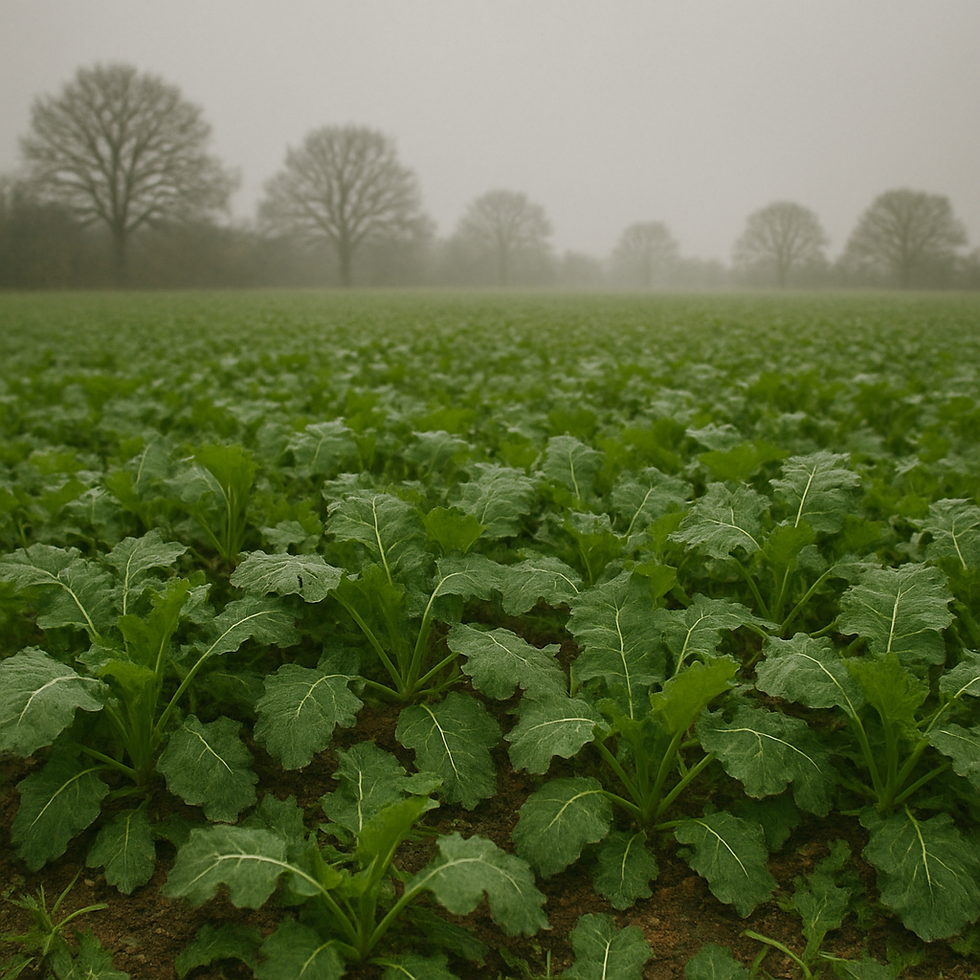Fertiliser Tax: The Straw That Broke the Soil’s Back
- Soil Fertility Services Ltd

- Oct 27
- 4 min read
There’s a mood running through the forums, and you can feel it in the tone of farmers everywhere. Not the usual muttering about red diesel or rainfall, this is deeper. The fertiliser tax, dressed up as a “Carbon Border Adjustment Mechanism,” has landed like a wet policy manual on an already soggy desk.
In theory, it’s simple: make polluters pay for the carbon footprint of imported fertiliser. In practice, it’s farmers who foot the bill, while imports made with the same, or worse, emissions waltz into the UK tariff-free. The kind of logic only civil servants can write with a straight face.
A tonne of ammonium nitrate produced in the UK is suddenly a climate crime; the same tonne produced in Poland or Morocco, however, apparently comes wrapped in green virtue. Because, you see, it’s not our emissions anymore. We’ve “offshored” them. That’s how Britain achieves net zero, by moving the goalposts abroad.
The irony, of course, is that the very farmers being taxed into submission are the ones who could actually fix the problem, literally. In the soil.
You can sense the despair online:
“They can’t make you buy it and grow crops worth little.”
“Fallow is the future.”
“Why aren’t the NFU sorting this out?”
And they’re not wrong to be angry. Fertiliser used to be a lever of productivity; now it’s a lever of policy. Every kilo of N has become a political statement. The same government that promotes “sustainable farming” taxes the inputs that built the food system, while offering no viable alternative to replace them.
Except… there is a route. Just not one they wrote into policy.
It doesn’t come in a blue bag, and it doesn’t carry a carbon tariff.
It’s called air.
Seventy-eight percent of the atmosphere above every field is nitrogen gas (N₂). Locked up, inert, until the right biology gets involved. That’s where biological nitrogen fixation comes in.
I can already hear you saying, “Ah, yes, I knew it.. here it comes”, “The sales pitch.”
But stick with me here…. Yes, we sell products, but we also care about the soil. So I’m going to tell you how you could minimise the impact of this CBAM tax and help your soils.

SFS has a product called Bio-N that works around the root zone to convert atmospheric nitrogen into plant-available ammonium and amino forms.
Not theoretically. Not in ten years when the technology “matures.” Right now, in fields across the UK.
Every litre of Bio-N contains billions of living cells ready to colonise the rhizosphere, pulling in nitrogen gas from the air and feeding it directly into the plant’s system. It’s a similar biological process that clover uses, except we’ve bottled it and made it mobile.
What that means in practice:
Trials have shown that you can cut synthetic N by 30–50 kg/ha without compromising yield.
You save roughly 0.32 tonnes of CO₂e per 50 kg N reduced, enough to start turning your carbon ledger from red to black.
You’re no longer held hostage by fertiliser markets, foreign gas prices, or carbon border taxes dreamt up in Brussels and rubber-stamped in Westminster.
There’s a grim sort of humour in watching politicians try to monetise the air, but in truth, it’s the one resource they can’t meter.
Biological nitrogen fixation sidesteps the entire system.
No shipping emissions, no gas feedstock, no carbon tariff, no “scope three” nonsense.
Just microbes, moisture, roots, and time.
That’s not greenwashing; it’s ecology doing what it’s always done before humans invented spreadsheets. This isn’t about going back to the horse and plough. It’s about moving forward with intelligence.
Synthetic fertiliser will still have a place, but it shouldn’t be the crutch it’s become. By working with biological systems, you can maintain protein yield and soil structure while reducing input costs and exposure to policy volatility.
Farmers who’ve integrated Bio-N into their nitrogen programme are already seeing steadier growth curves. It’s the difference between drip-feeding your crop through biology or dosing it with a quick chemical binge. One builds resilience; the other builds dependency.
So, what’s the real carbon story?
Every kilogram of manufactured nitrogen fertiliser carries a hidden carbon price tag, roughly 6–7 kg of CO₂e per kilogram of N, before you even open the bag. Apply 200 kg N/ha and you’ve just inherited 1.2 tonnes of carbon debt per hectare. Multiply that across the farm and suddenly “net zero” looks like a cruel joke.
Cut that rate by even 25%, and you’re clawing back hundreds of kilos and saving money. Do it biologically, and you also build soil carbon through increased microbial activity. That’s the part no one in Westminster seems to grasp: when you feed biology, it feeds you back. The fertiliser tax isn’t the end of farming, it’s a line in the sand. A chance to draw breath and say, ‘We can do this differently.’
We don’t need permission to farm smarter.
We just need to trust what the soil’s been doing since long before DEFRA discovered PowerPoint.
Bio-N is the countermove, a way to fix your own nitrogen, reduce your carbon liability, and remind policymakers that biology always trumps bureaucracy.
Bio-N – The Natural Nitrogen Fix
Let them tax nitrogen. Ours comes from the air.




Comments